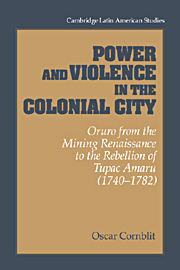 Power and Violence in the Colonial City
Power and Violence in the Colonial City Book contents
- Frontmatter
- Contents
- List of figure, maps, and tables
- Preface
- Map 1 Present-day Bolivia and surrounds
- Map 2 Principal routes of the Viceroyalty of Peru (second half of the eighteenth century)
- 1 Oruro between two epochs: a mining cycle
- 2 Under Spanish law
- 3 Oruro in 1741: details of a stormy election
- 4 The people
- 5 “Madmen, comedians, and hypocrites”
- 6 Captains of shipwreck
- 7 Returning to the known
- 8 “The fruits of the earth”
- 9 The end of an epoch: the Indian uprisings of 1780–1781
- 10 Oruro in the economic and geopolitical context of the epoch (c. 1780–1781)
- 11 The Oruro uprising
- 12 The voice of the rebels
- 13 Picking up the pieces
- Appendix A Indian raids on Oruro, 1781: testimonies
- Appendix B Testimonies of inhabitants of the city
- Appendix C Table of public jobs in Oruro, 1730–1784
- Bibliography
- Index
- CAMBRIDGE LATIN AMERICAN STUDIES
8 - “The fruits of the earth”
Published online by Cambridge University Press: 30 March 2010
- Frontmatter
- Contents
- List of figure, maps, and tables
- Preface
- Map 1 Present-day Bolivia and surrounds
- Map 2 Principal routes of the Viceroyalty of Peru (second half of the eighteenth century)
- 1 Oruro between two epochs: a mining cycle
- 2 Under Spanish law
- 3 Oruro in 1741: details of a stormy election
- 4 The people
- 5 “Madmen, comedians, and hypocrites”
- 6 Captains of shipwreck
- 7 Returning to the known
- 8 “The fruits of the earth”
- 9 The end of an epoch: the Indian uprisings of 1780–1781
- 10 Oruro in the economic and geopolitical context of the epoch (c. 1780–1781)
- 11 The Oruro uprising
- 12 The voice of the rebels
- 13 Picking up the pieces
- Appendix A Indian raids on Oruro, 1781: testimonies
- Appendix B Testimonies of inhabitants of the city
- Appendix C Table of public jobs in Oruro, 1730–1784
- Bibliography
- Index
- CAMBRIDGE LATIN AMERICAN STUDIES
Summary
The litigious tradition of the residents of Oruro and the notable disorder of their daily lives cannot be comprehended without establishing a few links to their basic economic activity: mining. The social and economic development of mining towns in Spanish America showed peculiarities that distinguished them from other kinds of settlements. In the opinion of two authors,
Characteristic of every mining center … is rapid growth after the discovery of the mines, an epoch of splendor and then the slow decline and abandonment of the city when the natural riches that gave rise to its establishment are exhausted. Sometimes the city continues to exist, changing its economic base, and survives through time with a different physiognomy.
Such economic vicissitudes give rise, predictably, to conflicts and irreconcilable confrontations like those described in the preceding chapters, as well as to peculiar strategies of alliance among different groups, some of which will be analyzed in the last part of this book.
In keeping with the local economic activity, one of the most frequently mentioned places in the documents of this period in Oruro – after the cabildo and the church – is the caja real, or royal treasury. Its importance is easily understood: it was the legally mandatory destination of miners who needed to have their silver cast into ingots.
In fact, not only miners used the services of the caja. It was also used by the “mercaderes deplata” or silver dealers; in general, anyone who possessed minerals or pieces of silver was eligible to use the caja?
This was, however, the final step in an arduous process, the costs of which were not always proportional to the effort required.
- Type
- Chapter
- Information
- Power and Violence in the Colonial CityOruro from the Mining Renaissance to the Rebellion of Tupac Amaru (1740–1782), pp. 92 - 109Publisher: Cambridge University PressPrint publication year: 1995


